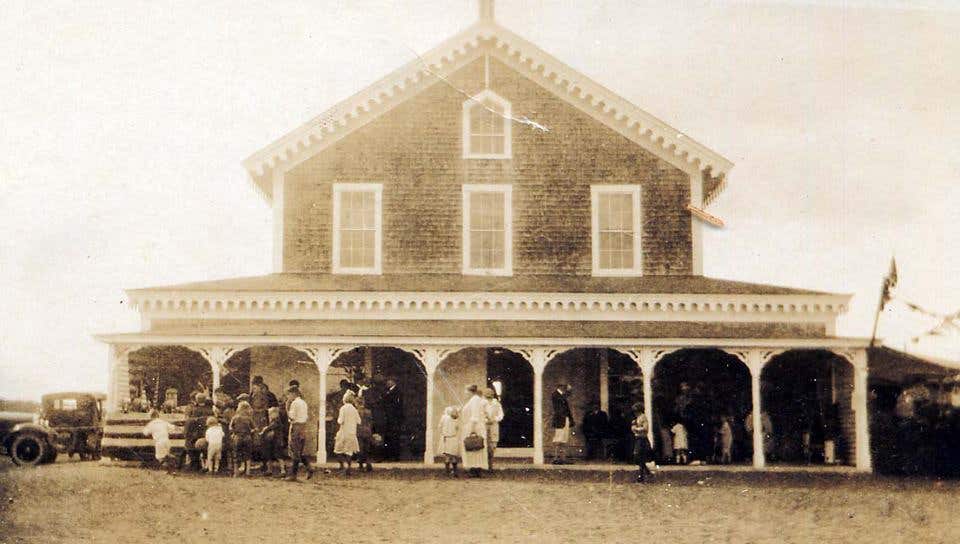
Peter Miller
Grange Hall: My Favorite Building
Grange Hall is one of my favorite traditional buildings because of how it looks, where it is, and how it’s used. It’s simple symmetry, with tall divided light windows, shingle exterior and welcoming front porch, makes me stop and stare, every time I pass by.
Grange Hall is a post and beam agricultural building, a barn, built in 1859 by the Martha’s Vineyard Agricultural Society. It is one of several buildings on this island owned and managed by the Preservation Trust, now re-named The Vineyard Trust. Martha’s Vineyard is an island off the southeastern coast of Massachusetts; my family’s summer vacation destination for two generations. A lot has been written about Martha’s Vineyard in part because writers live here, or visit, especially when U.S. Presidents show up.
Grange Hall is in West Tisbury, several miles from the busy towns on the island’s harbors. Like other Granges around rural America, it is a gathering place. Early on it was where farmers traded best practices and bartered for goods. For a long time, it was the site of the Martha’s Vineyard Agricultural Fair, featuring contests of all kinds, from blue ribbon hogs to blueberry pies. Now it hosts a farmer’s market and craft fairs. My grown kids still display, with pride, Ag Fair ribbons won for art projects, things made with clamshells and driftwood.
The Vineyard Trust manages other historic sites around this island, from the Flying Horses Carousel in Oak Bluffs to the Sculpin Gallery in Edgartown to Alley’s General Store in West Tisbury. The Trust hosts lectures, book signings and other special events which make their historic buildings more relevant than the typical behind-the-velvet-rope old house museums you visited in fifth grade. It’s a good example of how Preservation organizations everywhere are making themselves more useful, less stuffy and more engaging. Down island in Edgartown, the Trust hosts historic walking tours.
Grange Hall is a place where memories have been made. It’s creaky floors, rough-hewn beams and wavy glass windows have enchanted farmers, fishermen, folk artists and friends for 150 years.
Peter H. Miller, Hon. AIA, is the publisher and President of TRADITIONAL BUILDING, PERIOD HOMES and the Traditional Building Conference Series, and podcast host for Building Tradition, Active Interest Media's business to business media platform. AIM also publishes OLD HOUSE JOURNAL; NEW OLD HOUSE; FINE HOMEBUILDING; ARTS and CRAFTS HOMES; TIMBER HOME LIVING; ARTISAN HOMES; FINE GARDENING and HORTICULTURE. The Home Group integrated media portfolio serves over 50 million architects, builders, craftspeople, interior designers, building owners, homeowners and home buyers.
Pete lives in a classic Sears house, a Craftsman-style Four Square built in 1924, which he has lovingly restored over a period of 30 years. Resting on a bluff near the Potomac River in Washington, D.C., just four miles from the White House, Pete’s home is part of the Palisades neighborhood, which used to be a summer retreat for the District’s over-heated denizens.
Before joining Active Interest Media (AIM), Pete co-founded Restore Media in 2000 which was sold to AIM in 2012. Before this, Pete spent 17 years at trade publishing giant Hanley Wood, where he helped launch the Remodeling Show, the first trade conference and exhibition aimed at the business needs and interests of professional remodeling contractors. He was also publisher of Hanley Wood’s Remodeling, Custom Home, and Kitchen and Bath Showroom magazines and was the creator of Remodeling’s Big 50 Conference (now called the Leadership Conference).
Pete participates actively with the American Institute of Architects’ Historic Resources Committee and also serves as President of the Washington Mid Atlantic Chapter of the Institute of Classical Architecture & Art. He is a long-time member of the National Trust for Historic Preservation and an enthusiastic advocate for urbanism, the revitalization of historic neighborhoods and the benefits of sustainability, including the adaptive reuse of historic buildings.








